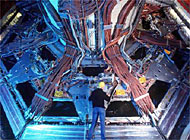Cern gets to the heart of matter

Scientists in Switzerland have provided a definitive answer to one of nature's best-kept secrets - why the Universe contains stars and galaxies, and even ourselves, rather than just being a vast empty space.
The Cern particle physics laboratory outside Geneva has conclusively demonstrated why matter prevailed over antimatter when the Universe came into being. The answer lies in a tiny difference between the two forms of matter.
The effect, known as direct Charge Parity (CP) violation, helps to explain why the Universe exists at all. It turns out that when matter and antimatter collide, a residue of matter remains, and it is this which accounts for everything in the Universe today.
“This is a fundamental question because everything as we understand it was created in the Big Bang, this huge explosion of energy, which gave birth to our Universe,” said Neil Calder, spokesman for Cern.
“In the Big Bang, equal quantities of matter and antimatter should have been produced. Now, when matter and antimatter come into contact, they annihilate each other so the equal quantities of the two forms of matter should have wiped each other out in a cosmic cataclysm, leaving nothing.
“But here we are, living in a matter universe. So one of the big questions is why did matter emerge victorious from this first colossal battle at the beginning of the Universe?
“There should be some small difference, some ingredient in matter which allowed this to happen and to try to find out what this is, is one of the big quests of modern physics.”
Rate of decay
To find the effect, scientists observed the behaviour of a sub-atomic particle, called a neutral K meson. After 10 years of research and analysis, scientists conclusively determined that there was a tiny difference in the decay rates of these particles and their antiparticles.
Calder said the research showed the rigour and precision of scientific research. He said initial results, published in 1993, were not precise enough to confirm that direct CP-violation was a real effect.
Study into the effect is continuing. “We have now seen direct CP-violation without any shadow of doubt so this is now a scientific result which is no longer under discussion,” said Calder.
“But to understand how it happens, or indeed why matter was the strongest, we still need to determine what ingredient in CP-violation allowed matter to win.”
CP-violation was first observed in 1964 by scientists at the Brookhaven laboratory in the United States. Their Nobel prize-winning experiment showed that particles called long-lived neutral kaons occasionally decay into two pions, a CP-violating process.
However the origins of this process remained mysterious. The long and rigorous research carried out at Cern has now established direct CP-violation as fact.
by Vincent Landon

In compliance with the JTI standards
More: SWI swissinfo.ch certified by the Journalism Trust Initiative
You can find an overview of ongoing debates with our journalists here . Please join us!
If you want to start a conversation about a topic raised in this article or want to report factual errors, email us at english@swissinfo.ch.